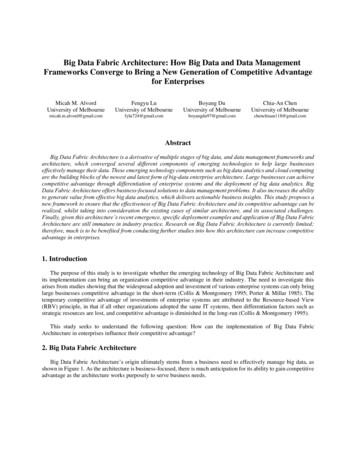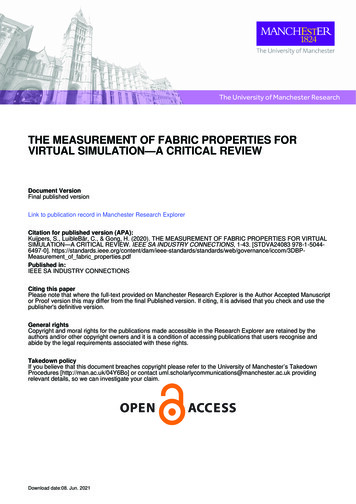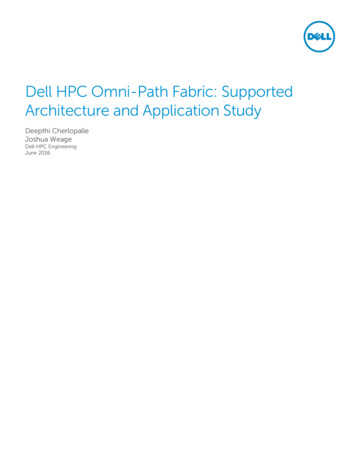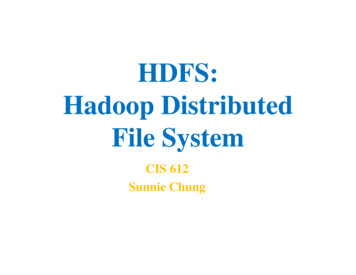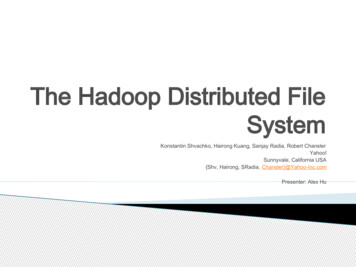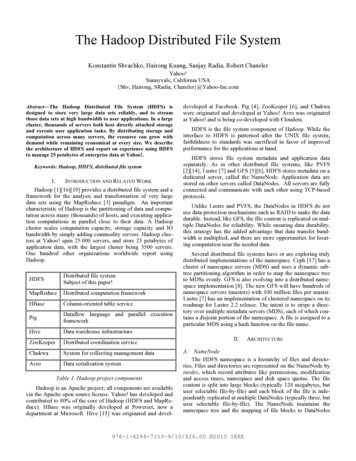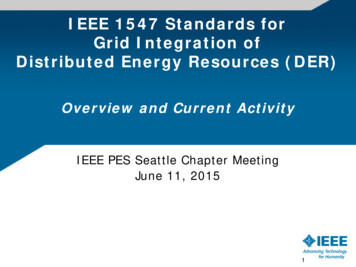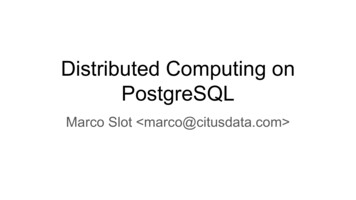
Transcription
Hyperledger Fabric: A Distributed Operating System forPermissioned BlockchainsElli AndroulakiArtem BargerVita BortnikovChristian CachinKonstantinos ChristidisAngelo De CaroDavid EnyeartIBMChristopher FerrisGennady LaventmanYacov ManevichIBMIBMChet Murthy Srinivasan Muralidharan Binh Nguyen State Street Corp.State Street Corp.Manish SethiGari SinghKeith SmithAlessandro SorniottiChrysoula StathakopoulouMarko VukolićSharon Weed CoccoJason YellickIBMIBMABSTRACTFabric is a modular and extensible open-source system for deployingand operating permissioned blockchains and one of the Hyperledgerprojects hosted by the Linux Foundation (www.hyperledger.org).Fabric is the first truly extensible blockchain system for runningdistributed applications. It supports modular consensus protocols,which allows the system to be tailored to particular use cases andtrust models. Fabric is also the first blockchain system that runsdistributed applications written in standard, general-purpose programming languages, without systemic dependency on a nativecryptocurrency. This stands in sharp contrast to existing blockchain platforms that require “smart-contracts” to be written indomain-specific languages or rely on a cryptocurrency. Fabric realizes the permissioned model using a portable notion of membership,which may be integrated with industry-standard identity management. To support such flexibility, Fabric introduces an entirely novelblockchain design and revamps the way blockchains cope with nondeterminism, resource exhaustion, and performance attacks.This paper describes Fabric, its architecture, the rationale behind various design decisions, its most prominent implementationaspects, as well as its distributed application programming model.We further evaluate Fabric by implementing and benchmarkinga Bitcoin-inspired digital currency. We show that Fabric achievesend-to-end throughput of more than 3500 transactions per secondin certain popular deployment configurations, with sub-secondlatency, scaling well to over 100 peers. Workdone at IBM.Permission to make digital or hard copies of part or all of this work for personal orclassroom use is granted without fee provided that copies are not made or distributedfor profit or commercial advantage and that copies bear this notice and the full citationon the first page. Copyrights for third-party components of this work must be honored.For all other uses, contact the owner/author(s).EuroSys ’18, April 23–26, 2018, Porto, Portugal 2018 Copyright held by the owner/author(s).ACM ISBN 90508.3190538ACM Reference Format:Elli Androulaki, Artem Barger, Vita Bortnikov, Christian Cachin, Konstantinos Christidis, Angelo De Caro, David Enyeart, Christopher Ferris, Gennady Laventman, Yacov Manevich, Srinivasan Muralidharan, Chet Murthy,Binh Nguyen, Manish Sethi, Gari Singh, Keith Smith, Alessandro Sorniotti,Chrysoula Stathakopoulou, Marko Vukolić, Sharon Weed Cocco, and Jason Yellick. 2018. Hyperledger Fabric: A Distributed Operating System forPermissioned Blockchains . In EuroSys ’18: Thirteenth EuroSys Conference2018, April 23–26, 2018, Porto, Portugal. ACM, New York, NY, USA, 15 ODUCTIONA blockchain can be defined as an immutable ledger for recordingtransactions, maintained within a distributed network of mutuallyuntrusting peers. Every peer maintains a copy of the ledger. Thepeers execute a consensus protocol to validate transactions, groupthem into blocks, and build a hash chain over the blocks. Thisprocess forms the ledger by ordering the transactions, as is necessary for consistency. Blockchains have emerged with Bitcoin [3]and are widely regarded as a promising technology to run trustedexchanges in the digital world.In a public or permissionless blockchain anyone can participatewithout a specific identity. Public blockchains typically involve anative cryptocurrency and often use consensus based on “proof ofwork” (PoW) and economic incentives. Permissioned blockchains,on the other hand, run a blockchain among a set of known, identified participants. A permissioned blockchain provides a way tosecure the interactions among a group of entities that have a common goal but which do not fully trust each other, such as businessesthat exchange funds, goods, or information. By relying on the identities of the peers, a permissioned blockchain can use traditionalByzantine-fault tolerant (BFT) consensus.Blockchains may execute arbitrary, programmable transactionlogic in the form of smart contracts, as exemplified by Ethereum [5].The scripts in Bitcoin were a predecessor of the concept. A smartcontract functions as a trusted distributed application and gainsits security from the blockchain and the underlying consensus
EuroSys ’18, April 23–26, 2018, Porto, Portugalamong the peers. This closely resembles the well-known approachof building resilient applications with state-machine replication(SMR) [48]. However, blockchains depart from traditional SMR withByzantine faults in important ways: (1) not only one, but manydistributed applications run concurrently; (2) applications may bedeployed dynamically and by anyone; and (3) the application code isuntrusted, potentially even malicious. These differences necessitatenew designs.Many existing smart-contract blockchains follow the blueprintof SMR [48] and implement so-called active replication [27]: a protocol for consensus or atomic broadcast first orders the transactionsand propagates them to all peers; and second, each peer executesthe transactions sequentially. We call this the order-execute architecture; it requires all peers to execute every transaction and alltransactions to be deterministic. The order-execute architecture canbe found in virtually all existing blockchain systems, ranging frompublic ones such as Ethereum (with PoW-based consensus) to permissioned ones (with BFT-type consensus) such as Tendermint [14],Chain [4] and Quorum [13]. Although the order-execute design isnot immediately apparent in all systems, because the additionaltransaction validation step may blur it, its limitations are inherentin all: every peer executes every transaction and transactions mustbe deterministic.Prior permissioned blockchains suffer from many limitations,which often stem from their permissionless relatives or from usingthe order-execute architecture. In particular: Consensus is hard-coded within the platform, which contradicts the well-established understanding that there is no“one-size-fits-all” (BFT) consensus protocol [52]; The trust model of transaction validation is determined bythe consensus protocol and cannot be adapted to the requirements of the smart contract; Smart contracts must be written in a fixed, non-standard, ordomain-specific language, which hinders wide-spread adoption and may lead to programming errors; The sequential execution of all transactions by all peers limitsperformance, and complex measures are needed to preventdenial-of-service attacks against the platform originatingfrom untrusted contracts (such as accounting for runtimewith “gas” in Ethereum); Transactions must be deterministic, which can be difficult toensure programmatically; Every smart contract runs on all peers, which is at odds withconfidentiality, and prohibits the dissemination of contractcode and state to a subset of peers.In this paper we describe Hyperledger Fabric or simply Fabric,an open-source [8] blockchain platform that overcomes these limitations. Fabric is one of the projects of Hyperledger [7] under theauspices of the Linux Foundation [11]. Fabric is used in more than400 prototypes, proofs-of-concept, and in production distributedledger systems, across different industries and use cases. These usecases include but are not limited to areas such as dispute resolution, trade logistics, FX netting, food safety, contract management,diamond provenance, rewards point management, low liquiditysecurities trading and settlement, identity management, and settlement through digital currency.E. Androulaki et al.Fabric introduces a new blockchain architecture aiming at resiliency, flexibility, scalability, and confidentiality. Designed asa modular and extensible general-purpose permissioned blockchain, Fabric is the first blockchain system to support the execution of distributed applications written in standard programminglanguages, in a way that allows them to be executed consistentlyacross many nodes, giving impression of execution on a singleglobally-distributed blockchain computer. This makes Fabric thefirst distributed operating system [54] for permissioned blockchains.The architecture of Fabric follows a novel execute-order-validateparadigm for distributed execution of untrusted code in an untrusted environment. It separates the transaction flow into threesteps, which may be run on different entities in the system: (1) executing a transaction and checking its correctness, thereby endorsingit (corresponding to “transaction validation” in other blockchains);(2) ordering through a consensus protocol, irrespective of transaction semantics; and (3) transaction validation per applicationspecific trust assumptions, which also prevents race conditions dueto concurrency.This design departs radically from the order-execute paradigmin that Fabric typically executes transactions before reaching final agreement on their order. It combines the two well-knownapproaches to replication, passive and active, as follows.First, Fabric uses passive or primary-backup replication [21, 27]as often found in distributed databases, but with middleware-basedasymmetric update processing [40, 41] and ported to untrustedenvironments with Byzantine faults. In Fabric, every transaction isexecuted (endorsed) only by a subset of the peers, which allows forparallel execution and addresses potential non-determinism, drawing on “execute-verify” BFT replication [37]. A flexible endorsementpolicy specifies which peers, or how many of them, need to vouchfor the correct execution of a given smart contract.Second, Fabric incorporates active replication in the sense thatthe transaction’s effects on the ledger state are only written afterreaching consensus on a total order among them, in the deterministic validation step executed by each peer individually. This allowsFabric to respect application-specific trust assumptions accordingto the transaction endorsement. Moreover, the ordering of stateupdates is delegated to a modular component for consensus (i.e.,atomic broadcast), which is stateless and logically decoupled fromthe peers that execute transactions and maintain the ledger. Sinceconsensus is modular, its implementation can be tailored to thetrust assumption of a particular deployment. Although it is readilypossible to use the blockchain peers also for implementing consensus, the separation of the two roles adds flexibility and allows oneto rely on well-established toolkits for CFT (crash fault-tolerant) orBFT ordering.Overall, this hybrid replication design, which mixes passive andactive replication in the Byzantine model, and the execute-ordervalidate paradigm, represent the main innovation in Fabric architecture. They resolve the issues mentioned before and make Fabrica scalable system for permissioned blockchains supporting flexibletrust assumptions.To implement this architecture, Fabric contains modular buildingblocks for each of the following components:
Hyperledger Fabric: A Distributed Operating System for Permissioned Blockchains An ordering service atomically broadcasts state updates topeers and establishes consensus on the order of transactions. A membership service provider is responsible for associatingpeers with cryptographic identities. It maintains the permissioned nature of Fabric. An optional peer-to-peer gossip service disseminates the blocksoutput by ordering service to all peers. Smart contracts in Fabric run within a container environmentfor isolation. They can be written in standard programminglanguages but do not have direct access to the ledger state. Each peer locally maintains the ledger in the form of theappend-only blockchain and as a snapshot of the most recentstate in a key-value store.The remainder of this paper describes the architecture of Fabricand our experience with it. Section 2 summarizes the state of theart and explains the rationale behind various design decisions. Section 3 introduces the architecture and the execute-order-validateapproach of Fabric in detail, illustrating the transaction executionflow. In Section 4, the key components of Fabric are defined, in particular, the ordering service, membership service, peer-to-peer gossip, ledger database, and smart-contract API. Results and insightsgained in a performance evaluation of Fabric with a Bitcoin-inspiredcryptocurrency, deployed in a cluster and WAN environments oncommodity public cloud VMs, are given in Section 5. They show thatFabric achieves, in popular deployment configurations, throughputof more than 3500 tps, achieving finality [57] with latency of a fewhundred ms and scaling well to over 100 peers. In Section 6 wediscuss a few real production use cases of Fabric. Finally, Section 7discusses related work.2 BACKGROUND2.1 Order-Execute Architecture forBlockchainsAll previous blockchain systems, permissioned or not, follow theorder-execute architecture. This means that the blockchain network orders transactions first, using a consensus protocol, and thenexecutes them in the same order on all peers sequentially.1For instance, a PoW-based permissionless blockchain such asEthereum combines consensus and execution of transactions asfollows: (1) every peer (i.e., a node that participates in consensus) assembles a block containing valid transactions (to establish validity,this peer already pre-executes those transactions); (2) the peer triesto solve a PoW puzzle [44]; (3) if the peer is lucky and solves thepuzzle, it disseminates the block to the network via a gossip protocol; and (4) every peer receiving the block validates the solution tothe puzzle and all transactions in the block. Effectively, every peerthereby repeats the execution of the lucky peer from its first step.Moreover, all peers execute the transactions sequentially (withinone block and across blocks). The order-execute architecture isillustrated by Fig. 1.Existing permissioned blockchains such as Tendermint, Chain, orQuorum typically use BFT consensus [24], provided by PBFT [26] orother protocols for atomic broadcast. Nevertheless, they all follow1 In many blockchains with a hard-coded primary application, such as Bitcoin,this transaction execution is called “transaction validation.” Here we call this steptransaction execution to harmonize the terminology.EuroSys ’18, April 23–26, 2018, Porto, PortugalOrder Consensus oratomic broadcastExecute Deterministic (!)executionUpdate state Persist state onall peersFigure 1: Order-execute architecture in replicated services.the same order-execute approach and implement classical activeSMR [27, 48].2.2Limitations of Order-ExecuteThe order-execute architecture is conceptually simple and thereforealso widely used. However, it has several drawbacks when used ina general-purpose permissioned blockchain. We discuss the threemost significant ones next.Sequential execution. Executing the transactions sequentially onall peers limits the effective throughput that can be achieved bythe blockchain. In particular, since the throughput is inversely proportional to the execution latency, this may become a performancebottleneck for all but the simplest smart contracts. Moreover, recallthat in contrast to traditional SMR, the blockchain forms a universalcomputing engine and its payload applications might be deployedby an adversary. A denial-of-service (DoS) attack, which severelyreduces the performance of such a blockchain, could simply introduce smart contracts that take a very long time to execute. Forexample, a smart contract that executes an infinite loop has a fataleffect, but cannot be detected automatically because the haltingproblem is unsolvable.To cope with this issue, public programmable blockchains with acryptocurrency account for the execution cost. Ethereum [58], forexample, introduces the concept of gas consumed by a transactionexecution, which is converted at a gas price to a cost in the cryptocurrency and billed to the submitter of the transaction. Ethereumgoes a long way to support this concept, assigns a cost to everylow-level computation step, introducing its own VM for controllingexecution. Although this appears to be a viable solution for publicblockchains, it is not adequate in the permissioned model for ageneral-purpose system without a native cryptocurrency.The distributed-systems literature proposes many ways to improve performance compared to sequential execution, for instancethrough parallel execution of unrelated operations [46]. Unfortunately, such techniques are still to be applied successfully in theblockchain context of smart contracts. For instance, one challengeis the requirement for deterministically inferring all dependenciesacross smart contracts, which is particularly challenging when combined with possible confidentiality constraints. Furthermore, thesetechniques are of no help against DoS attacks by contract code fromuntrusted developers.Non-deterministic code. Another important problem for an orderexecute architecture are non-deterministic transactions. Operationsexecuted after consensus in active SMR must be deterministic, orthe distributed ledger “forks” and violates the basic premise of ablockchain, that all peers hold the same state. This is usually addressed by programming blockchains in domain-specific languages
EuroSys ’18, April 23–26, 2018, Porto, Portugal(e.g., Ethereum Solidity) that are expressive enough for their applications but limited to deterministic execution. However, suchlanguages are difficult to design for the implementer and requireadditional learning by the programmer. Writing smart contractsin a general-purpose language (e.g., Go, Java, C/C ) instead appears more attractive and accelerates the adoption of blockchainsolutions.Unfortunately, generic languages pose many problems for ensuring deterministic execution. Even if the application developerdoes not introduce obviously non-deterministic operations, hiddenimplementation details can have the same devastating effect (e.g., amap iterator is not deterministic in Go). To make matters worse,on a blockchain the burden to create deterministic applications lieson the potentially untrusted programmer. Only one non-deterministic contract created with malicious intent is enough to bring thewhole blockchain to a halt. A modular solution to filter divergingoperations on a blockchain has also been investigated [23], but itappears costly in practice.E. Androulaki et al.potentially adversarial environments [52]. A protocol with a “chain”communication pattern exhibits provably optimal throughput on aLAN cluster with symmetric and homogeneous links [34], but degrades badly on a wide-area, heterogeneous network. Furthermore,external conditions such as load, network parameters, and actualfaults or attacks may vary over time in a given deployment. Forthese reasons, BFT consensus should be inherently reconfigurableand ideally adapt dynamically to a changing environment [17]. Another important aspect is to match the protocol’s trust assumptionto a given blockchain deployment scenario. Indeed, one may want toreplace BFT consensus with a protocol based on an alternative trustmodel such as XFT [43], or a CFT protocol, such as Paxos/Raft [45]and ZooKeeper [36], or even a permissionless protocol.2.4Experience with Order-Execute BlockchainConfidentiality of execution. According to the blueprint of publicblockchains, many permissioned systems run all smart contractson all peers. However, many intended use cases for permissioned blockchains require confidentiality, i.e., that access to smartcontract logic, transaction data, or ledger state can be restricted.Although cryptographic techniques, ranging from data encryptionto advanced zero-knowledge proofs [18] and verifiable computation [42], can help to achieve confidentiality, this often comes witha considerable overhead and is not viable in practice.Fortunately, it suffices to propagate the same state to all peersinstead of running the same code everywhere. Thus, the executionof a smart contract can be restricted to a subset of the peers trustedfor this task, that vouch for the results of the execution. This design departs from active replication towards a variant of passivereplication [21], adapted to the trust model of blockchain.Prior to realizing the execute-order-validate architecture of Fabric, we gained experience with building a permissioned blockchainplatform in the order-execute model, with PBFT [26] for consensus. Namely, previous versions of Fabric (up to v0.6, released inSeptember 2016) have been architected following the ‘traditional‘order-execute architecture.From feedback obtained in many proof-of-concept applications,the limitations of this approach became immediately clear. Forinstance, users often observed diverging states at the peers and reported a bug in the consensus protocol; in all cases, closer inspectionrevealed that the culprit was non-deterministic transaction code.Other complaints addressed limited performance, e.g., “only fivetransactions per second,” until users confessed that their averagetransaction took 200ms to execute. We have learned that the keyproperties of a blockchain system, namely consistency, security,and performance, must not depend on the knowledge and goodwillof its users, in particular since the blockchain should run in anuntrusted environment.2.33Further Limitations of ExistingArchitecturesFixed trust model. Most permissioned blockchains rely on asynchronous BFT replication protocols to establish consensus [57].Such protocols typically rely on a security assumption that amongn 3f peers, up to f are tolerated to misbehave and exhibit socalled Byzantine faults [20]. The same peers often execute the applications as well, under the same security assumption (even thoughone could actually restrict BFT execution to fewer peers [59]). However, such a quantitative trust assumption, irrespective of peers’roles in the system, may not match the trust required for smartcontract execution. In a flexible system, trust at the applicationlevel should not be fixed to trust at the protocol level. A generalpurpose blockchain should decouple these two assumptions andpermit flexible trust models for applications.Hard-coded consensus. Fabric is the first blockchain system thatintroduced pluggable consensus. Before Fabric, virtually all blockchain systems, permissioned or not, came with a hard-coded consensus protocol. However, decades of research on consensus protocolshave shown there is no such “one-size-fits-all” solution. For instance,BFT protocols differ widely in their performance when deployed inARCHITECTUREIn this section, we introduce the three-phase execute-order-validatearchitecture and then explain the transaction flow.3.1Fabric OverviewFabric is a distributed operating system for permissioned blockchains that executes distributed applications written in generalpurpose programming languages (e.g., Go, Java, Node.js). It securelytracks its execution history in an append-only replicated ledgerdata structure and has no cryptocurrency built in.Fabric introduces the execute-order-validate blockchain architecture (illustrated in Fig. 2) and does not follow the standard orderexecute design, for reasons explained in Section 2. In a nutshell, adistributed application for Fabric consists of two parts: A smart contract, called chaincode, which is program codethat implements the application logic and runs during theexecution phase. The chaincode is the central part of a distributed application in Fabric and may be written by an untrusted developer. Special chaincodes exist for managing theblockchain system and maintaining parameters, collectivelycalled system chaincodes (Sec. 4.6).
Hyperledger Fabric: A Distributed Operating System for Permissioned BlockchainsExecute Simulate trans.and endorseCreate rw-setCollect endorsements Order Order rw-setsAtomic broadcast(consensus)Stateless orderingserviceMSPValidate Validate endorsements & rw-setsEliminate invalidand conflictingtrans.EuroSys ’18, April 23–26, 2018, Porto, PortugalClientUpdate state Persist state on allpeersClientSDK Appl.Appl. SDKPOSNA client sends transactions to the peers specified by the endorsement policy. Each transaction is then executed by specific peersand its output is recorded; this step is also called endorsement. Afterexecution, transactions enter the ordering phase, which uses a pluggable consensus protocol to produce a totally ordered sequenceof endorsed transactions grouped in blocks. These are broadcastto all peers, with the (optional) help of gossip. Unlike standard active replication [48], which totally orders transaction inputs, Fabricorders transaction outputs combined with state dependencies, ascomputed during the execution phase. Each peer then validatesthe state changes from endorsed transactions with respect to theendorsement policy and the consistency of the execution in the validation phase. All peers validate the transactions in the same orderand validation is deterministic. In this sense, Fabric introduces anovel hybrid replication paradigm in the Byzantine model, whichcombines passive replication (the pre-consensus computation ofstate updates) and active replication (the post-consensus validationof execution results and state changes).A Fabric blockchain consists of a set of nodes that form a network(see Fig. 3). As Fabric is permissioned, all nodes that participate inthe network have an identity, as provided by a modular membershipservice provider (MSP) (Sec. 4.1). Nodes in a Fabric network take upone of three roles: Clients submit transaction proposals for execution, help orchestrate the execution phase, and, finally, broadcast transactions for ordering. Peers execute transaction proposals and validate transactions.All peers maintain the blockchain ledger, an append-onlydata structure recording all transactions in the form of ahash chain, as well as the state, a succinct representation ofthe latest ledger state. Not all peers execute all transactionPPPPPPPeers (P)Peer-to-peer gossipFigure 2: Execute-order-validate architecture of Fabric (rwset means a readset and writeset as explained in Sec. 3.2). An endorsement policy that is evaluated in the validationphase. Endorsement policies cannot be chosen or modifiedby untrusted application developers. An endorsement policy acts as a static library for transaction validation in Fabric, which can merely be parameterized by the chaincode.Only designated administrators may have a permission tomodify endorsement policies through system managementfunctions. A typical endorsement policy lets the chaincodespecify the endorsers for a transaction in the form of a setof peers that are necessary for endorsement; it uses a monotone logical expression on sets, such as “three out of five” or“(A B) C.” Custom endorsement policies may implementarbitrary logic (e.g., our Bitcoin-inspired cryptocurrency inSec. 5.1).POSNOSNOSNOSNOrderingserviceFigure 3: A Fabric network with federated MSPs and runningmultiple (differently shaded and colored) chaincodes, selectively installed on peers according to policy.proposals, only a subset of them called endorsing peers (or,simply, endorsers) does, as specified by the policy of thechaincode to which the transaction pertains. Ordering Service Nodes (OSN) (or, simply, orderers) are thenodes that collectively form the ordering service. In short, theordering service establishes the total order of all transactionsin Fabric, where each transaction contains state updatesand dependencies computed during the execution phase,along with cryptographic signatures of the endorsing peers.Orderers are entirely unaware of the application state, anddo not participate in the execution nor in the validationof transactions. This design choice renders consensus inFabric as modular as possible and simplifies replacement ofconsensus protocols in Fabric.A Fabric network actually supports multiple blockchains connected to the same ordering service. Each such blockchain is calleda channel and may have different peers as its members. Channelscan be used to partition the state of the blockchain network, butconsensus across channels is not coordinated and the total order oftransactions in each channel is separate from the others. Certain deployments that consider all orderers as trusted may also implementby-channel access control for peers. In the following we mentionchannels only briefly and concentrate on one single channel.In the next three sections we explain the transaction flow inFabric (depicted in Fig. 4) and illustrate the steps of the execution,ordering, and validation phases. Then, we summarize the trust andfault model of Fabric (Sec. 3.5).3.2Execution PhaseIn the execution phase, clients sign and send the transaction proposal(or, simply, proposal) to one or more endorsers for execution. Recallthat every chaincode implicitly specifies a set of endorsers viathe endorsement policy. A proposal contains the identity of thesubmitting client (according to the MSP), the transaction payload inthe form of an operation to execute, parameters, and the identifierof the chaincode, a nonce to be used only once by each client (suchas a counter or a random value), and a transaction identifier derivedfrom the client identifier and the nonce.
EuroSys ’18, April 23–26, 2018, Porto, Portugal1 ng5Broadcast/Deliveryordering service12 EndorsementcollectionE.
across many nodes, giving impression of execution on a single globally-distributed blockchain computer. This makes Fabric the firstdistributed operating system [54] for permissioned blockchains. The architecture of Fabric follows a novel execute-order-validate paradigm for distributed
